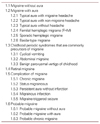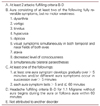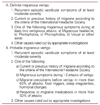Abstract
Patients with migraine frequently have hypersensitivity to light, sound, and smell. In addition to these hallmark features of migraine, patients often describe vestibular complaints ranging from true vertigo to less specific symptoms of dizziness, unsteadiness, and head motion intolerance. Over the last two decades a number of studies have stressed the association of migraine with vestibular and ocular motor disorders. Migraine may be a most common cause of various forms of episodic vertigo, but definite diagnostic criteria for migraine related vertigo are still lacking. As migrainous vertigo is an evolving entity, terminology is confusing and generally accepted diagnostic criteria are not established. The interrelations of migraine and dizziness can be classified into seven categories: (1) vertigo as an aura of migraine-basilar type migraine, (2) episodic vertigo attack without typical temporal relationship to migraine headache-migraine equivalent, (3) vertigo/dizziness during migraine attack, (4) susceptibility of motion sickness in migraine patients, (5) CACNA1A gene mutation and migraine-familial hemiplegic migraine, episodic ataxia type 2, (6) well defined vertigo syndromes that are not caused by migraine but show a statistical association with migraine-Meniere's disease, BPPV, (7) non-vestibular dizziness in migraine patients-psychiatric comorbidity, antimigraine medication. Each part of categories will be discussed.
Figures and Tables
References
1. Headache classification committee of the international headache society. Classification and diagnostic criteria for headache disorders, cranial neuralgias and facial pain. Cephalalgia. 1988. 8:S7. 1–96.
2. The international classification of headache disorders: 2nd ed. Cephalalgia. 2004. 24:S1. 9–160.
3. Lipton RB, Dodick D, Sadovsky R, Kolodner K, Endicott J, Hettiarachchi J, Harrison W. ID Migraine validation study. A self - administered screener for migraine in primary care: The ID Migraine validation study. Neurology. 2003. 61:375–382.

4. Neuhauser H, Leopold M, von Brevern M, Arnold G, Lempert T. The interrelations of migraine, vertigo, and migrainous vertigo. Neurology. 2001. 56:436–441.

5. Cass SP, Furman JM, Ankerstjerne K, Balaban C, Yetiser S, Aydogan B. Migraine-related vestibulopathy. Ann Otol Rhinol Laryngol. 1997. 106:182–189.

7. Olsson JE. Neurotologic findings in basilar migraine [Review]. Laryngoscope. 1991. 101:1–41.
10. Johnson GD. Medical management of migraine-related dizziness and vertigo. Laryngoscope. 1998. S 85. 1–28.

11. Savundra PA, Carroll JD, Davies RA, Luxon LM. Migraine-associated vertigo. Cephalalgia. 1997. 17:505–510. discussion 487.

14. Neuhauser H, Lempert T. Vertigo and dizziness related to migraine: A diagnostic challenge. Cephalalgia. 2004. 24:83–91.

15. Dieterich M, Brandt T. Episodic vertigo related to migraine (90 cases): vestibular migraine? J Neurol. 1999. 246:883–892.

16. Kayan A, Hood JD. Neuro-otological manifestations of migraine. Brain. 1984. 107(Pt 4):1123–1142.

17. Kolev O. How caloric vestibular irritation influences migraine attacks. Cephalalgia. 1990. 10:167–169.

18. Furman JM, Marcus DA, Balaban CD. Migrainous vertigo: development of a pathogenetic model and structured diagnostic interview. Curr Opin Neurol. 2003. 16:5–13.

19. Carmona S, Settecase N. Use of topiramate (topamax) in a subgroup of migraine-vertigo patients with auditory symptoms. Ann N Y Acad Sci. 2005. 1039:517–520.

20. Baloh RW, Foster CA, Yue Q, Nelson SF. Familial migraine with vertigo and essential tremor. Neurology. 1996. 46:458–460.

21. Abu-Arafeh I, Russel G. Paroxysmal vertigo as a migraineequivalent in children: a population based study. Cephalalgia. 1993. 15:22–25.

22. Bayazit Y, Yilmaz M, Mumbuc S, Kanlikana M, Assessment of. Assessment of migraine-related cochleovestibular symptoms. Rev Laryngol Otol Rhinol (Bord). 2001. 122:85–88.
23. Harker LA. Baloh RW, Halmagyi GM, editors. Migraine associated vertigo. Disorders of the vestibular system. 1996. Oxford: Oxford University Press;407–417.
24. Kuritzky A, Ziegler DK, Hassanein R. Vertigo, motion sickness and migraine. Headache. 1981. 21:227–231.

25. Barabas G, Matthews WS, Ferrari M. Childhood migraine and motion sickness. Pediatrics. 1983. 72:188–190.

26. Radtke A, Lempert T, Gresty MA, Brookes GB, Bronstein AM, Neuhauser H. Migraine and Meniere's disease: is there a link? Neurology. 2002. 59:1700–1704.

27. Ishiyama A, Jacobson KM, Baloh RW. Migraine and benign positional vertigo. Ann Otol Rhinol Laryngol. 2000. 109:377–380.

28. Lempert T, Leopold M, von Mrevern M, Neuhauser H. Migraine and benign positional vertigo. Ann Otol Rhinol Laryngol. 2000. 109:1176.

29. Lee H, Sohn SI, Jung DK, Cho YW, Lim JG, Yi SD, Yi HA. Migraine and isolated recurrent vertigo of unknown cause. Neurol Res. 2002. 24:663–665.

30. Margraf J, Taylor B, Ehlers A, Roth WT, Agras WS. Panic attacks in the natural environment. J Nerv Ment Dis. 1987. 175:558–565.
31. Breslau N, Schultz LR, Stewart WF, Lipton RB, Lucia VC, Welch KM. Headache and major depression: Is the association specific to migraine? Neurology. 2000. 54:308–313.

32. Breslau N, Schultz LR, Stewart WF, Lipton R, Welch KM. Headache types and panic disorder: Directionality and specificity. Neurology. 2001. 56:350–354.

34. Persoons P, Luyckx , Desloovere C, Vandenberghe J, Fischler B. Anxiety and mood disorders in otorhinolaryngology outpatients presenting with dizziness: validation of the self administered PRIME-MD Patient Health Questionnaire and epidemilology. Gen Hosp Psychiatry. 2003. 25:316–323.

35. Eckhardt-Henn A, Breuer P, Thomalske C. Anxiety disorders and other psychiatric subgroups in patients complaining of dizziness. J Anxiety Disord. 2003. 17:369–388.

36. Lance JW, Anthony M. Some clinical aspects of migraine. A prospective study of 500 patients. Arch Neurol. 1966. 15:356–361.
37. Drummond PD. Relationships among migrainous, vascular and orthostatic symptoms. Cephalalgia. 1982. 2:157–162.

38. Bes A, Dupui P, Guell A, Bessoles G, Geraud G. Pharmacological exploration of uiodopamine hypersensitivity in migraine patients. Int J Clin Pharmacol Res. 1986. 6:189–192.




 PDF
PDF ePub
ePub Citation
Citation Print
Print










 XML Download
XML Download